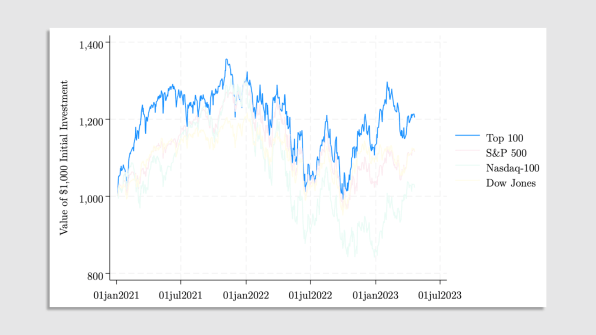- | 9:00 am
The business case for investing in employee wellbeing
While many CEOs are championing cost cuts, they are missing the biggest opportunity for success.

The economy today is in something of a paradox: strong fundamentals, including the lowest unemployment rate since the 1960s, but weak sentiment: CEOs are pessimistic, and generally people feel the economy is not good. To navigate this era, managers have turned to the old playbook: “the year of efficiency,” as Mark Zuckerberg called it.
While business leaders are focused on incremental optimization (which mostly involves layoffs, budget cuts, and price rises), a new paper from Oxford University, building on millions of employee reviews from the job platform Indeed, shows more clearly than ever that a paradigm shift is available: prioritizing employee wellbeing could transform companies, and the economy, in driving long-term business success.
While most companies say some version of “our people are our most important asset,” they clearly do not prioritize it: only 29% of people are thriving at work, and only one third of managers have any strategy for work wellbeing. This “wellbeing deficit” clearly takes an enormous toll on people, affecting hundreds of millions of lives, but also creates a giant economic loss: companies with higher wellbeing scores generate significantly better profit, command higher valuations, and outperform the stock market.
WELLBEING IS THE FOUNDATION OF SUCCESS
Oxford’s Wellbeing Research Centre, led by Professor Jan-Emmanuel De Neve, has articulated a clear approach to measuring wellbeing at work. Ultimately it boils down to four things: people’s overall happiness, their satisfaction at work, whether they feel purpose in their work, and how stressed they are.
These outcomes, taken together, articulate a clear picture of how people are doing. To understand why, we need to investigate drivers of wellbeing, like whether people feel included and supported, that they are growing, or find belonging at work. This approach to measuring wellbeing was incorporated into the job platform Indeed starting in 2019, enabling employees to rate the wellbeing they experienced at their respective companies.
With 250 million visitors per month, this dataset of reviews became the largest of its kind in the world, and is used to assign a “Work Wellbeing Score” to thousands of companies. (Disclosure: my company, Enso, helped Indeed and Oxford conceive this project and has partnered with them for the past four years; Oxford has full discretion over its academic analysis)
The new analysis recently published from Oxford seeks to answer the question: in addition to being a morally virtuous choice for leaders to invest in employee wellbeing, do high wellbeing companies see stronger financial performance? Small studies in the past indicate such a link within individual companies, and some studies have used proxies of employee wellbeing like company star ratings, but there has not been research that looks at thousands of companies, sourced from millions of employee surveys, based on standard measures of wellbeing.
The answer is resoundingly, yes. Well-being is strongly linked to financial performance.
The Oxford team looked at the Work Wellbeing Score of publicly listed companies, alongside the publicly available financial data for those companies. Companies with higher wellbeing show a superior return on assets, generate higher profits, and command higher valuations.

Even more strikingly, high company well-being levels were not only predictive of contemporaneous firm performance, but of future firm performance. The Oxford team looked at the wellbeing data for companies before Covid, and the financial performance after Covid; the results showed the same link between wellbeing and return on assets, profits and firm value.
To explore the link to financial performance even further, the Oxford team created a virtual stock portfolio with the 100 highest wellbeing companies using wellbeing data from the previous year, then followed the market performance of that portfolio (e.g. the top 100 wellbeing companies for 2021 made the 2022 portfolio).
This ‘Wellbeing 100’ portfolio significantly outperformed the major stock market indices. An investment of $1,000 in the ‘Wellbeing 100’ in January 2021 would have risen to $1,300 by March 2023, 20% higher than an investment in the S&P 500 and 30% higher than the Nasdaq. It’s also striking that this out-performance sustained in good times, and bad; high wellbeing companies were more resilient through market turbulence, and significantly more positive in up-market conditions.
While many people will find it intuitive that people with high wellbeing are able to contribute to their companies at a higher level, some skeptical business leaders may point out that these analyses are correlative rather than causative: that working for a successful company creates wellbeing.
That is true, but as the Oxford team pointed out, “across industries, between companies, and over time, wellbeing is proving to be an ever more important predictor of company performance.” In a separate analysis, the same team at Oxford demonstrated a causal link from happiness to productivity, as part of a seven-year study into worker performance at one company. We can also look at a plethora of research that demonstrates why wellbeing creates superior work output, from enhanced creativity to superior employee retention.
WHY DOES HIGHER WELLBEING DRIVE SUPERIOR FINANCIAL PERFORMANCE?
There are six ways wellbeing affects performance.
The first is productivity—there is compelling evidence of a strong positive—and mutually reinforcing—relationship between wellbeing and productivity. In a study of employees in a call center, employees who were in a better mood handled calls more efficiently and resolved more issues. In another study of manufacturing workers in Finland, researchers found that a 1% increase in job satisfaction increased productivity by 6.6%.
The second impact is in building relationships. There are clear positive feedback loops between wellbeing and relationships: people with high wellbeing have more friends, engage in more social activities, and spend more time talking to others. Happier employees develop more supportive relationships with colleagues and supervisors, are more collaborative, have more satisfied and loyal customers, and are better negotiators.
The third link to performance is creativity. Significant research has shown how well-eing creates the conditions for novel and useful ideas. Studies have shown that people who are happier have enhanced problem solving skills, and that happiness enhances group creativity as well as individual creativity.
The fourth connection between wellbeing and productivity is health. Wellbeing has been linked to an array of health indicators and behaviors, and those links are often reciprocal (ie, wellbeing promotes health, and health promotes wellbeing). Happier people live longer, experience less pain, have lower blood pressure, lower body mass index, and improved immune function.
Well-being is also predictive of lower rates of smoking and drinking, and higher rates of exercise, sleep and good nutrition. Poor health leads to absenteeism and presenteeism (working while sick); employees with lower satisfaction are more likely to arrive late, leave work early, and miss days entirely.
Recruitment is the fifth link. People choose jobs for more than just a paycheck, and workers are willing to trade some financial compensation for wellbeing factors, like autonomy, flexibility and purpose. A recent MIT study on Indeed data showed that job seekers direct their applications to higher-happiness companies than less happy ones.
The sixth tie between wellbeing and performance is retention. Estimates of costs associated with employee turnover range from one half to five times the workers’ original annual salary—and may cost the U.S. economy $1 trillion. Managing retention is of critical financial importance. Evidence shows that wellbeing predicts lower stated intention to leave and lower employee turnover.
These last two drivers become even more important as the quality of wellbeing data improves. The labor market has been inefficient: it has been too hard to tell which companies and jobs create wellbeing, so workers, jobseekers and managers have made crucial decisions with imperfect information.
Metrics like Indeed’s Work Wellbeing Score help correct this market inefficiency by giving everyone much greater visibility, so natural market forces will drive an even-greater flow of talent towards the best companies. The incentive for companies to invest real energy in creating wellbeing will only get stronger as transparency increases.
SOLVING THE EFFICIENCY PARADOX
While the benefits of employee wellbeing may seem self-evident, many managers remain concerned about the perceived trade-off between efficiency and wellbeing. In a drive for efficiency, which so often means limiting the very things that make work more fulfilling, enriching and joyful, leaders may curtail the very thing they are really looking for: financial health.
There is a wealth of guidance, research, books and consulting advice available informing leaders how to foster wellbeing at their company. Many people think that pay is the primary driver of work wellbeing, but the Indeed data reveals that pay is not as significant as the social dynamics around work: particularly whether people feel belonging and feel included.
But the most important hurdle to overcome in the quest for greater wellbeing is leaders’ legacy attachment to prioritizing profit over people, leading to worse outcomes for both. Without real intention towards wellbeing, no progress is possible.
In one study, 87% of executives and managers said improving workplace wellbeing could give their companies a competitive advantage, but only about one third have a strategy in place to do so. It’s no surprise that only 29% of people in Indeed’s research report high wellbeing.
Closing this gap, between stated belief and real action, is the key to companies realizing their potential contribution to the world’s 3 billion workers, and their own financial performance. The narrative around work, from “hustle culture” to “grinding” to “year of efficiency” has created a cultural pressure that work should feel bad. This misperception, revealed more clearly than ever by the new Oxford analysis, should be replaced by a more optimistic and accurate narrative: thriving people create thriving companies.






































